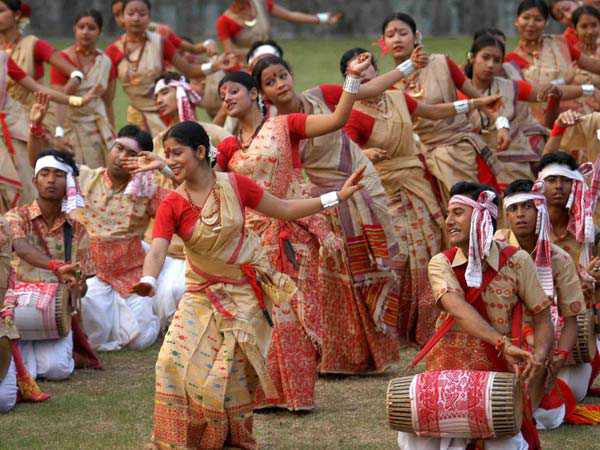In this blog, we’ll be looking at a state from northeast India. It is known for its wildlife, tea plantations, and varied culture. The state is a delightful blend of culture, heritage, faiths, and beliefs. It is a melting pot of the numerous ethnic tribes and sub-tribes residing in the state. The state is ASSAM.
Hence, this article will give you full-fledged information about the cultural, geographical and political aspects of Assam.
Do you know which state in India has the World’s largest River Island? Which state is known as “The Land of the Red River and Blue Hills” and Why?
The state symbols are very essential because they can be used to put the feeling of pride and unity in a state’s population. State symbols are used to signify the importance of that particular state. So let’s look at state symbols of Assam:
| State Capital | Dispur |
| State Dance | Bihu |
| State Animal | Indian Rhinoceros |
| State Bird | White-winged Duck |
| State Flower | Foxtail Orchid |
| State Tree | Hollong |
| State CM (Present) | Sarbananda Sonowal |
| State Governor (Present) | Jagdish Mukhi |
Let’s start with the very first topic, that is,
Table of Contents
ASSAM CULTURE GK Notes
Assam is the meeting ground of diverse cultures. Assam culture is influenced by the Ahom Dynasty and the Koch Kingdom who ruled the region for many years. The culture and tradition of the state, its music, dance and literature are all interwoven into the social fabric.
- The native people of Assam are called Asomiya (Assamese), an Indo-Aryan language, which is also the state language of Assam. The natives of Assam are a mixture of Mongoloid, Indo-Burmese, Indo-Iranian and Aryan.
- The state has a large number of tribes out of which Bodo are the largest tribe in Assam, white chakma, chutia, dimasa and other tribes are also there.
- The state is known for one of its kind Assamese Golden Silk called Muga which is produced only in Assam. The silk is known for its extreme durability and has a natural yellowish-golden tint with a shimmering, glossy texture.
- Kamakhya Temple is located on Nilachal Hill of Guwahati. It is an ancient and very famous hindu temple devoted to goddess Kamakhya (one of the incarnations of goddess Durga).
- Assam is full of festivals, the most important being the BIHU. It is celebrated to mark the important points of a cultivator’s life over a yearly cycle. A non-religious festival which is celebrated irrespective of caste and creed.
- Rongali or Bohag Bihu celebrated in Mid-April with the coming of spring and the beginning of the sowing season. It is also known as Rangaali Bihu (“rang” means merry-making). The first day of Rongali Bihu is called “Goru Bihu” when the cows are taken to the nearby ponds to be bathed.
- Kangaali Bihu (Kangaali means poor) is celebrated in mid-October. It is called so because by this time the harvest is brought home.
- The Magh Bihu is celebrated in mid-January. There are community feasts and bonfires which take place. It is also known as Bhogaali Bihu (“Bhog” means enjoyment and feasting).
- Gamosa is an indispensable part of almost all socio-religious ceremonies in Assam. Literally translated, it means ‘something to wipe the body with’ (Ga=body, mosa= to wipe).
- Its original term is Gamcha, interpreting the word ‘Gamosa’ as the body-wiping towel is misleading.
- It looks like a white rectangular piece of cloth along with a red border on three sides and woven motifs on the fourth.
- Bihu dancers wrap it around the head, it is often hung around the neck at the prayer hall and was thrown over the shoulder in the past to signify social status. It is used to cover the altar at the prayer hall or over the scriptures.
- The other things like Tamul Paan and Xorai are also important symbols. The former is considered as offers of devotion whereas the latter is a bell used for container medium.
- Assamese dishes are said to be less spicy than any other Indian dishes. Assamese are mostly non-vegetarian, and their staple diet is rice.
- Fish curry is another favourite which is prepared as a sour dish called Machor Tenga.
- Baked fish wrapped in leaves with white mustard paste is a popular delicacy called Patot Diya Mas where “pat” means leaf in Assamese.
- A traditional Assamese begins with Khar and ends with a spicy and tangy Tenga, Betelnut and paan conclude the meal.
- Khorisa is fermented bamboo shoots used to flavour curries, Koldli (bamboo flower) and squash are used as vegetables.
- The Assamese use bamboo to welcome guests because of their attachment to the bamboo culture. Known as Jaapi, this is basically known as the Sunshade of Assam. It is made of bamboo strips and dried palm leaves locally known as Tokow Pat.
- Assamese men wear Dhoti Gamosa, Dhoti is a piece of garment worn in the lower part of the body. The Dhoti is wrapped around the waist while Gamosa is a cloth rectangular in shape with a red border on three sides used to wipe hands.
- Assamese women wear Mekhela Chador, a two-piece garment. It is draped from the waist to downward and later tucked into the waist with a triangular fold. Mekhela is worn around the waist with few folds and the Chador is draped around the body and bringing it back to the waist and tucked in. Although it looks like a saree, it is different from a saree as it got two parts i.e. Mekhela and Chador.
- Ali-Ai-Ligang – This is a spring festival and the name of the festival is made up of three terms – ‘Ali’ which means root and seed, ‘Ai’ means fruit and ‘Ligang’ means to sow.
- Ojapali, Devdasi and Satriya are the major dancing styles of Assam. The dances of the Bodos are associated with the Kherai Puja festival where Bagurumba dance is the most popular.
- The jewellery is simple and decorated with ruby or mina. The traditional ones worn by men are called Biri, Magardana, Matamoni, Kundal and Lokapora whereas the ones worn by women are Keru, Karphul, Kharu, Aargathi, Nalak and Keyur.
Let us jump to another interesting topic –
ASSAM GEOGRAPHY GK Notes
The state boasts of a fertile agricultural land and there are quaint hills in Assam that adorn the state with their majesty.
- Latitudinal Extension – 240 N to 280 N
- Longitudinal Extension – 890 E to 960 E
- Area – 78,438 sq.km
Rank in India – 16th
- Population (According to the 2011 census) – 31,169,272 or 3.9 crores
Rank in India – 15th
- Number of Districts – 33
- Literacy Rate – 72.19%
- Boundaries – The state is bordered by Bhutan and Arunachal Pradesh to the North, Nagaland and Manipur to the east, Tripura, Mizoram and Bangladesh, Meghalaya to the south and West Bengal to the west via the Siliguri Corridor.
- The Y-shaped state is divided into 3 physical regions –
- The Brahmaputra River Valley in the North.
- The Barak River/Upper Surma River Valley in the South.
- The Hilly region between Meghalaya (to the west) and Nagaland and Manipur (to the east) in the south-central part of the state.
- Climate – The climate of Assam is typically “Tropical Monsoon Rainfall” type, with high level of humidity and heavy rainfall.
- The summer reason is characterized by extreme humidity and frequent showers from the month of March and extends till the end of June. In fact, the mercury level never rises more than 380, even in the hottest month of the year.
- The monsoon season experiences an annual rainfall of 70 inches in the west and around 120 inches in the east. The neighbouring areas of Cherapunji and Mawsynram have the highest rainfall in the world. The thunderstorms known as Bordoicila, are very common in the state in afternoon in monsoon.
- The winter season starts in November and continues till the month of February. The mercury reading at this time of year is around 6 to 8 degrees Celsius or 43-46 degrees Fahrenheit.
- Soils – The soils of Assam are very rich in content of nitrogen and organic matter.
- The Alluvial soils of the Brahmaputra and the Barak valley are highly fertile as they are formed from the alluvial with deposits, deposited by the rivers Brahmaputra, Barak and their tributaries.
- The Piedmont soils are mainly found in the northern narrow zone along the piedmont zone of the Himalayan foothills. These soils comprise the Bhabar soil and the Tarai soil, covering respectively the Bhabar and Tarai Belt of the Brahmaputra Valley.
- The Hill soils are generally found in the southern hilly terrain of the state. The hill soils may be divided into red sandy soils and red loamy soils.
- The lateritic soils in the state extensively occur almost entirely over the N.C. Hills district while few patches are confined to the eastern margin of the Anglong district. These soils are dark and finely textured with heavy loams and deficient in nitrogen, potash, phosphoric acid and lime.
- Some of the important hills of the state are –
- Mikir Hills
- Rengam Hills
- Barail Range
- Bhuban Hills
- Brahmaputra river enters Assam near Sadiya in the extreme northeast and runs westward through the length of Assam for nearly 450 miles (725 km) before turning south to enter the plains of Bangladesh.
The last (but not least) aspect which is left in this part is–
ASSAM POLITY GK Notes
The Assam Legislature is Unicameral in nature and consists of 126 members in Assam Assembly.
- The Assam Assembly is presided over by the speaker, who is generally a member of the ruling party.
- The political structure of Assam in India is headed by the ceremonial post of the Governor. He is assisted by the council of ministers, headed by the CM, who are members of the Assam Assembly.
- In recent years, the Governor has become more powerful, especially because the last two Governors have been ex-Army Generals and the Army is entrusted with anti-insurgency operations against ULFA (United Liberation Front of Assam) and other armed groups.
- The High Court of Assam is in Guwahati, the largest city of the state. The Chief Justice is Ajai Lamba. He took oath on 7 October 2019.
- Representation of Assam in Parliament –
Rajya Sabha – 7
Lok Sabha – 14
- The first CM of Assam was Gopinath Bordoloi. His term of office was from 11 Feb 1946 to 6 August 1950. He was from Indian National Congress (INC).
- Since 1946, Assam has had 14 CMs. 10 of these belonged to the INC, including Gopinath Bordoloi, the first CM of Assam and Anwara Taimur, India’s first female Muslim CM. Congressman Tarun Gogoi is the longest service officeholder, having served for 15 years from 2001 to 2016.
- The current CM is Sarbananda Sonowal, the first CM from BJP when he was sworn in on 24 May 2016.
- The first Governor of Assam was Sir Muhammad Saleh Akbar Hydari from 4 May 1947 to 15 August 1947 and also from 15 August 1947 to 28 December 1948.
- The present Governor is Jagdish Mukhi since 10 October 2017. He is the 28th Governor.
Now, we’ll be ending this informative article with Some Interesting Facts –
- The Assam is known as “The Land of the Red River and Blue Hills”. The heavily silt-laden Brahmaputra, winding its way through the breadth of Assam looks reddish because of high sedimentation and is thus called Lauhitya (meaning red in local language). From a distance, the snow-capped Himalaya of Arunachal Pradesh and the heavily forested mountains of Meghalaya simmer, giving the Assamese horizon a blue haze. This is why the state is called “The Land of Red River and Blue Hills”.
- Siliguri Corridor (Chicken’s Neck) is a narrow stretch of land of about 22 km, located in the Indian state of West Bengal that connects India’s north-eastern states to the rest of India.
- The river Brahmaputra also forms the world’s largest River Island called “Majuli” in Assam and on 8 September 2016, it became the first island to be made a district in India.
- Assam is the Gateway of North-East India, dominated by Brahmaputra and Barak. A large part of Assam is situated in the narrow valley that these rivers have created over the period of time. Assam, also described as the Shangrila in the North-Eastern India is the Gateway to the North-East.
- The word “Assam” is derived from the word “asama” meaning “peerless” in the now extinct Ahom language.
- The mighty river Brahmaputra is also popularly known as the “Lifeline of Assam”. Futile lands on its banks develop a variety of crops, creating human civilization and its beauty attracts visitors throughout the year. It is also treated as one of the holiest rivers in India and the only Male River in the world.
This was all about this article and if you want to update yourself with plenty of knowledge regarding states and all, so just stay tuned and prepare well. Hope all your anonymous doubts would be cleared with these illuminating blogs and this would be a great help to you in your competitive exams such as CDS, RRB NTPC, NDA, BANK PO etc.
In the next blog, we will be discussing some very important facts about Assam’s History, Environment, Education, Economy, etc. Click here for Know your state ‘Assam’ – Part 2!
Thank You




